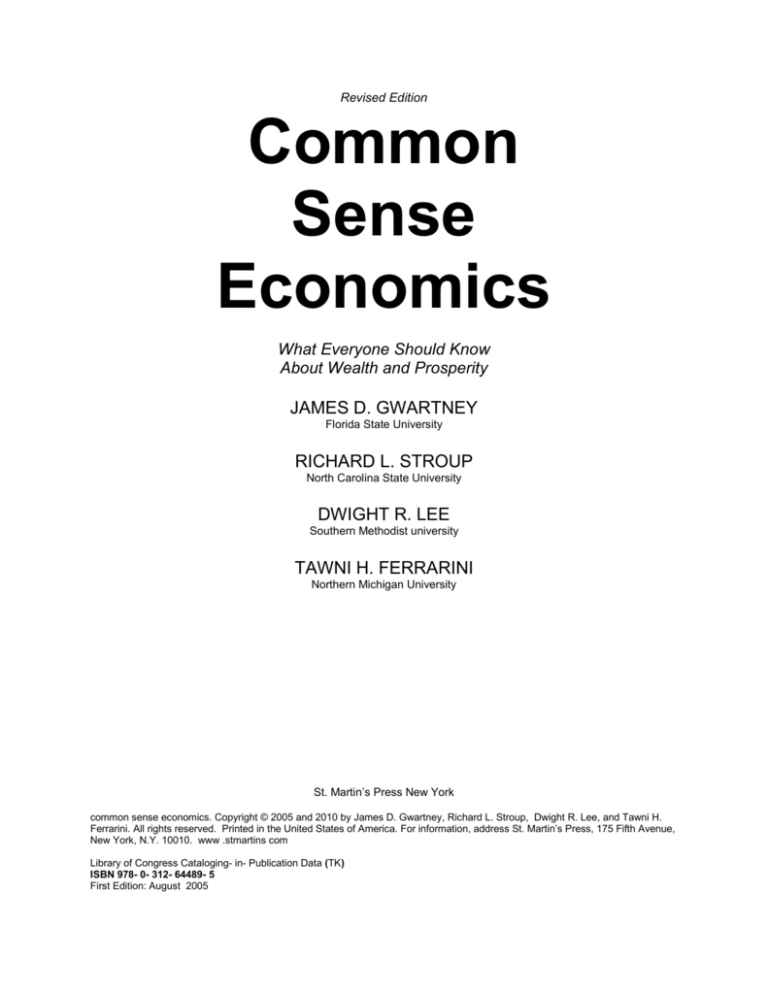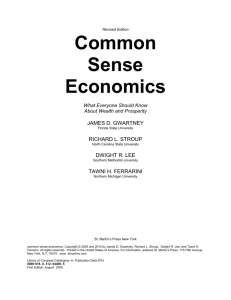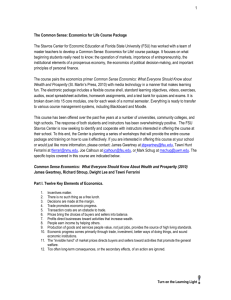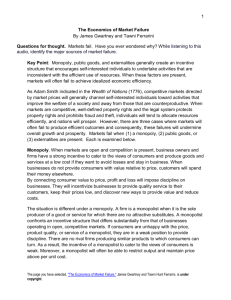
Revised Edition
Common
Sense
Economics
What Everyone Should Know
About Wealth and Prosperity
JAMES D. GWARTNEY
Florida State University
RICHARD L. STROUP
North Carolina State University
DWIGHT R. LEE
Southern Methodist university
TAWNI H. FERRARINI
Northern Michigan University
St. Martin’s Press New York
common sense economics. Copyright © 2005 and 2010 by James D. Gwartney, Richard L. Stroup, Dwight R. Lee, and Tawni H.
Ferrarini. All rights reserved. Printed in the United States of America. For information, address St. Martin’s Press, 175 Fifth Avenue,
New York, N.Y. 10010. www .stmartins com
Library of Congress Cataloging- in- Publication Data (TK)
ISBN 978- 0- 312- 64489- 5
First Edition: August 2005
Contents
Preface
ix
Part I: Twelve Key Elements of Economics
1
Part II: Seven Major Sources of Economic Progress
41
Part III: Economic Progress and the Role of Government
91
Part IV: Twelve Key Elements of Practical Personal Finance 145
ACKNOWLEDGMENTS
191
NOTES
193
GLOSSARY
203
LIST OF SUPPLEMENTAL UNITS
213
SUGGESTED ADDITIONAL READINGS
215
INDEX
217
ABOUT THE AUTHORS
225
Preface
Why Should You Read This Book?
We know that your time is valuable. Most of you do not want to spend a lot of time learning new terms,
memorizing formulas, or mastering details that are important only to professional economists. What you
want are the insights of economics that really matter—those that will help you make better personal
choices and improve your understanding of our complex world. And you want those insights to be
presented in a concise, organized, and readable manner, with a minimum of economics jargon. We wrote
this book to meet these objectives.
You can profit from this book regardless of your current knowledge of economics. This book will
introduce a beginner to the basic principles of economics, principles that mainly reflect common sense.
But these concepts are powerful tools for logical thinking that will quickly make it possible for even
beginners to distinguish between sound economics and romantic nonsense. This book will also help more
advanced students of economics and business pull together the “big picture.” Advanced students,
including some at the graduate level, are often so busy with graphs, formulas, models, and technical
mathematics that they fail to understand the really important lessons of economics. Finally, an
experienced business executive or a policy maker can also learn much of value from this book. Even
those who are highly successful at their jobs often underestimate the far-reaching, typically unintended
effects that political rules and policies have on the broader economic health of people and nations."
Now, as in the past, two visions are competing for the minds and hearts of Americans. One is of
limited government, economic freedom, and personal responsibility; the other, expanding government,
collectivism, and dependency. America was founded on the first, but the second has been in ascendance
for at least a century. Under the first vision, the economy will be directed by personal choices coordinated
by markets; under the second, by central planning and politics. It makes a big difference. As the
renowned Stanford economist, Thomas Sowell, has put it, “The first law of economics is scarcity, and the
first law of politics is to disregard the first law of economics.”
We have better knowledge about how these two alternatives work than at any time in history. But
we are a nation of economic illiterates. As a result, we are easily misled by leaders who tell us of their
good intentions – their passion to solve our problems. One of the 20th century’s greatest economists,
Milton Friedman, once stated, "There's nothing that does so much harm as good intentions." This was his
way of stressing that policies should be evaluated on the basis of their effectiveness, not the intentions of
their proponents.
President Herbert Hoover, Senator Reed Smoot, and Congressman Willis Hawley had good
intentions when they pushed the Smoot-Hawley tariff increases through Congress in 1930. Nonetheless,
the consequences of this legislation were disastrous; it helped turn what should have been a normal
th
downturn into a decade of pain and suffering. The 18 century surgeons also had good intentions; they
thought amputations without anesthesia bathed in wine would prevent diseases from getting into the
blood of their patients. But their good intentions did not protect their patients from the adverse affects of
their treatments. Neither will the good intentions of modern day politicians protect us from the
consequences of harmful policies.
The massive government intervention leading up to, and following, the economic crisis of 2008
has generated an increasingly urgent need for basic economic education. Our democracy puts voters in
charge of choosing our policy makers, so the consequences of economic illiteracy can be disastrous.
People who do not understand the sources of economic prosperity are susceptible to schemes that
undermine both their own prosperity and that of their country. A nation of economic illiterates is unlikely to
remain prosperous for very long.
If you are concerned about the direction of America and would like to see a road map for a more
economically free and prosperous future, this book provides it. The basic principles explained here will
help you better understand what types of economic arrangements work, what restraints on the political
process are needed to strengthen and preserve them, and thus why some nations prosper while others
stagnate or even regress. As a result, you will be able to make wiser choices as a citizen. But basic
economics will also help you make better choices with regard to your consumption, saving, investments,
career alternatives, and many other dimensions of personal decision-making. As we explain in Part IV,
economics provides some simple rules on how to build and grow wealthy. And in a market economy,
increasing your wealth helps others become wealthy too.
There is an Internet website, http://CommonSenseEconomics.com, that accompanies this book.
For those who want to dig deeper, the site includes supplementary units that address specific subjects
such as gross domestic product, measurement of inflation, banking and monetary policy, the Great
Depression, and the Economic Crisis of 2008. (Note: the full list of these topics is listed in the back of this
book.) These supplementary units were developed at the request of instructors using Common Sense
Economics as a text who wanted a more comprehensive analysis of various topics. This material will
meet this demand and provide instructors with maximum flexibility for the development of their course.
The CSE website also includes numerous other features such as study questions, a secured instructor’s
test bank, links to videos, classic readings that can be downloaded to a MP3 player, and many other
features that will make economics livelier for both students and instructors. Our goal is to make
economics fun, as well as informative.
—James Gwartney, Richard Stroup, Dwight Lee, and Tawni Ferrarini
April 2010








